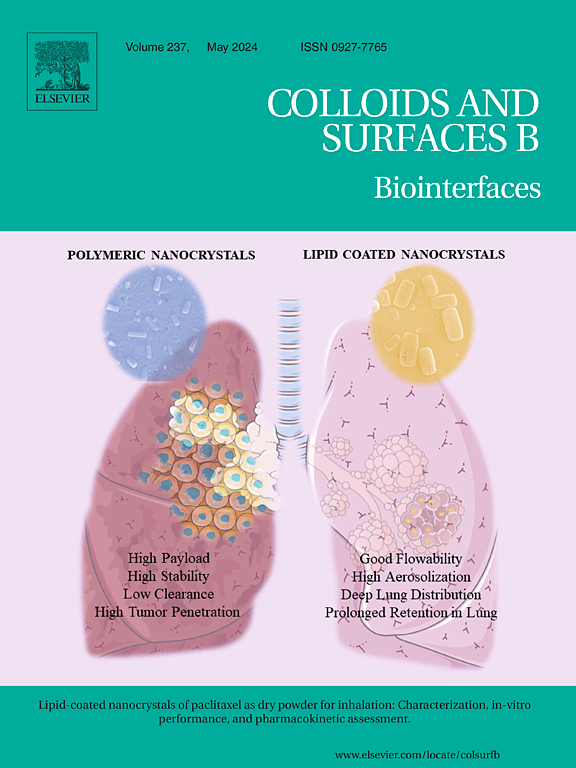双配体功能化纳米结构脂质载体作为治疗肝纤维化的新型脱氢卡维丁输送系统。
IF 5.6
2区 医学
Q1 BIOPHYSICS
引用次数: 0
摘要
背景:肝纤维化是各种慢性肝病的常见阶段:肝纤维化是各种慢性肝病的常见阶段,通常会发展为肝硬化,甚至肝癌。活化的肝星状细胞(aHSCs)已被证明能促进肝纤维化的发展。因此,肝脏双靶向联合疗法可能是治疗肝纤维化的有效策略。目的:本研究制备了新型纳米结构脂质载体(GA&GalNH2-DC-NLCs),选择脱氢卡维丁(DC)、甘草亭酸(GA)和半乳糖-PEG2000-NH2(GalNH2)作为靶向配体修饰的纳米结构脂质载体(NLCs),实现肝脏双靶向治疗肝纤维化:为了研究GA&GalNH2-DC-NLCs对肝脏的靶向作用及其对肝纤维化的治疗效果,我们建立了HSC-T6细胞模型和大鼠肝纤维化模型进行研究:结果:GA&GalNH2-DC-NLCs通过上调Bax的表达,提高了药物肝脏靶向效率和凋亡率。结果表明:GA&GalNH2-DC-NLCs通过上调Bax的表达促进药物肝脏靶向效率和细胞凋亡率,与无GA和/或GA修饰的NLCs和GalNH2修饰的NLCs相比,GA&GalNH2-DC-NLCs在体内表现出较少的细胞外基质(ECM)沉积、诱导aHSCs凋亡和更强的抗肝纤维化作用。这可能是因为GA或GalNH2修饰的NLC同时阻断了造血干细胞的活化并抑制了IL-6/STAT3通路:结论:GA&GalNH2-DC-NLCs是一种潜在的肝纤维化治疗策略。本文章由计算机程序翻译,如有差异,请以英文原文为准。
Dual-ligand-functionalized nanostructured lipid carriers as a novel dehydrocavidine delivery system for liver fibrosis therapy
Background
Liver fibrosis is a common stage of various chronic liver diseases, often developing into liver cirrhosis, and even liver cancer. Activated hepatic stellate cells (aHSCs) have been shown to promote the development of liver fibrosis. Therefore, dual-targeted combination therapy for liver may be an effective strategy for the treatment of liver fibrosis.
Purpose
In this study, the novel nanostructured lipid carriers (GA&GalNH2-DC-NLCs) were prepared for Dehydrocavidine (DC), glycyrrhetinic acid (GA) and galactose-PEG2000-NH2 (GalNH2) were selected as targeted ligand-modified nanostructured lipid carriers (NLCs), which enables dual-targeting to the liver for the treatment of liver fibrosis.
Study design
To study the targeting effect of GA&GalNH2-DC-NLCs on liver and its therapeutic effect on liver fibrosis, we established aHSC-T6 cell model and rat model of liver fibrosis for study.
Results
GA&GalNH2-DC-NLCs promoted drug liver targeting efficiency and apoptosis rate by upregulating the expression of Bax. It showed that compared with no and/or GA-modified NLCs and GalNH2-modified NLCs, GA&GalNH2-DC-NLCs exhibited less extracellular matrix (ECM) deposition, induced apoptosis of aHSCs, and stronger anti-fibrosis effects in vivo. This may be due the fact that GA or GalNH2-modifified NLCs simultaneously block HSCs activation and inhibit the IL-6/STAT3 pathway.
Conclusion
GA&GalNH2-DC-NLCs is thus a potential strategy for liver fibrosis treatment.
求助全文
通过发布文献求助,成功后即可免费获取论文全文。
去求助
来源期刊

Colloids and Surfaces B: Biointerfaces
生物-材料科学:生物材料
CiteScore
11.10
自引率
3.40%
发文量
730
审稿时长
42 days
期刊介绍:
Colloids and Surfaces B: Biointerfaces is an international journal devoted to fundamental and applied research on colloid and interfacial phenomena in relation to systems of biological origin, having particular relevance to the medical, pharmaceutical, biotechnological, food and cosmetic fields.
Submissions that: (1) deal solely with biological phenomena and do not describe the physico-chemical or colloid-chemical background and/or mechanism of the phenomena, and (2) deal solely with colloid/interfacial phenomena and do not have appropriate biological content or relevance, are outside the scope of the journal and will not be considered for publication.
The journal publishes regular research papers, reviews, short communications and invited perspective articles, called BioInterface Perspectives. The BioInterface Perspective provide researchers the opportunity to review their own work, as well as provide insight into the work of others that inspired and influenced the author. Regular articles should have a maximum total length of 6,000 words. In addition, a (combined) maximum of 8 normal-sized figures and/or tables is allowed (so for instance 3 tables and 5 figures). For multiple-panel figures each set of two panels equates to one figure. Short communications should not exceed half of the above. It is required to give on the article cover page a short statistical summary of the article listing the total number of words and tables/figures.
 求助内容:
求助内容: 应助结果提醒方式:
应助结果提醒方式:


